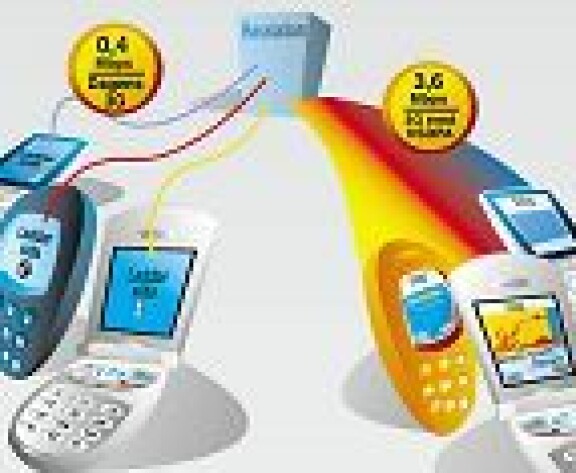-
PLUS
Krönika: Det här behöver Samsung göra för att lyckas 2026
-
PLUS
Så länge håller en mobil, snabbladdningens effekt och mer – Mobil svarar
-
PLUS
Krönika: Tre mobilhändelser som blir mina höjdpunkter 2026
-
PLUS
Mobil förutsäger mobilåret 2026 (del 1)
-
PLUS
Årets bästa produkter och viktigaste händelser – Mobil sammanfattar 2025
-
PLUS
Krönika: Okej, men hur agerar mobiloperatörerna i kaoset?
-
PLUS
Mobil svarar om telefonerna som blockeras i 2G- och 3G-nedstängningen
-
PLUS
PTS bär skulden när mobiler spärras med kort varsel
-
PLUS
Krönika: Bästa prylen jag någonsin köpt
-
PLUS
Nyheterna som gör mobilens batteri bättre
Broadband in the mobile

It gives ten times faster mobil internet than regular 3G. It is sometimes referred to as turbo 3G. The correct acronym is HSPA. Mobile Magazine explains why turbo 3G is the beginning of an internet revolution.
The 3G revolution was supposed to give us lightening fast internet. But anyone using it today knows that it is a bit slow to surf with. At least it is not as fast as regular broadband.
But 3G is not a static standard, it is constantly evolving. Faster internet access has been one of the important ingredients in the 3G planning. HSPA is short for High Speed Packet Access.
"Release 99" was the name of the first 3G specification, which was decided on at the end of the 90's. But when the 3G networks were taken into use, the plans were already much further ahead. HSPA is a technology included in the "Release 5" specification.
A channel just for you
When using the internet via 3G today, your mobile phone or data card gets a complete channel to the base station for the data transfer. The technology is called DCH - Dedicated Channel. The only problem is that each inp>HSPA (Release 5) means a switch to something called HS-DSCH - High-Speed Downlink Shared Channel. Using the new technology, means a higher bandwith channel is shared between several users. The base station adjusts the bandwidth all the time to the number of units using it at any given time, instead of keeping the channels inactive.
This is the fundamental difference, but not the entire explanation to why HSPA is better than today's 3G. How data packets are sent is a complex ordeal, and with HSPA the actual coding of information and the way packet data is transfered is changed.
The more effective use of the network bandwidth does not only give us faster internet access. It also means that the operator can use the network more efficiently for the increasing number of customers. The network can handle more customers. To us, the consumers, HSPA is marketed as a benefit to us, but it is even more important to the operators, in their strive to use their networks more efficiently, and to host more active 3G clients.
HSPA does not in any way mean that mobile operator have to rebuild their networks from the ground up. It is mainly sufficient to upgrade the software in the base stations. In a country like Sweden, that means upgrading around 30.000 base stations.
1.8 Mbps is the initial limit...
Theoretically, the current HSPA technology gives a max speed of 14.4 Megabit per second, Mbps. In practice the speed is lower than that. The first HSPA version will give 1.8 Mbps for downloads and web surfing. In the next version the speed will be 3.6 Mbps. Some operators start immediately with 3.6 Mbps in their networks.
The distance from the base station might affect the speed in a negative way. But no matter what, the speed will be ten times that of the current 3G networks, 384 kbps.
But even faster speeds are already planned for the future. HSPA with this speed will be available in the "Release 5". But in the next 3G version, "Release 6", we will again get twice the speed for downloads and surfing.
But Release 6 means more than that. It also includes so called HSUPA, High Speed Uplink Packet Access. That gives up to 5.8 Mbps for uploading and sending information, not only for downloading and surfing. That is naturally a big improvement for those in need of sending large files, like photographers.
...but 100 Mbps might be on its way
The speed is likely to continue to be increased in the 3G networks. There are talks about speeds up to 100 Mbps.
In Release 6 of the 3G standard is also included plans for interoperability and co-operation between WLAN and 3G. In addition, the MBMS technology is included, to transmit multimedia, for instance tv, via the mobile network, to many simultaneous viewers. That could be used to broadcast a soccer game, without overloading the mobile network.
HSUPA and Release 6 will also give new oppotunities for high quality IP telephony via 3G. With time, today's circuit switched mobile phone calls will be replaced with a more packet switched, internet technology.
The changes in the 3G standard transforms the mobile phones into broadband internet terminals. And HSPA is one step in that direction.





















